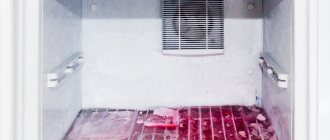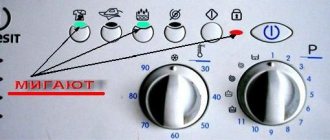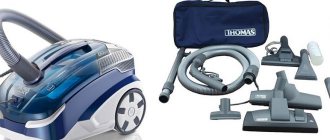Basic Rules
Indesit household refrigerators come in three types:
- devices with a know-frost defrosting system in both chambers (refrigerator and freezer);
- mixed-type appliances (the refrigerator compartment is equipped with a drip defrosting system, the freezer is equipped with a no-frost system);
- units with manual defrosting of chambers.
The rules for defrosting household appliances have some differences, depending on the refrigerator model:
- an old-style refrigerator that is not equipped with an automatic defrosting system requires a mandatory procedure at least once every 1-2 months;
- devices with drip defrosting of the refrigeration chamber and a know-frost system in the freezer require defrosting once every 4-6 months;
- Units in which the frost melting process is fully regulated by the automatic know frost system should be defrosted no more than once a year.
If you notice that a layer of ice has formed in the refrigerator and freezer compartments of the device, regardless of whether you have an old refrigerator model or a modern one (with a know-frost system), the device should be defrosted.
Frost prevents the maintenance of a given temperature in the chambers , as a result of which the risk of premature failure of the motor of an electrical appliance increases many times over.
IMPORTANT! It is advisable to defrost the device in the cool season (autumn, winter, early spring).
This is interesting: how to remove dents on a refrigerator at home.
How to defrost a No Frost refrigerator
Most refrigerators produced today are equipped with a No Frost system, which means “no frost.” However, this concept needs clarification. Refrigerators should be defrosted and cleaned in any case, otherwise the owner will have to deal with a breakdown or malfunction. Dust settles on the surface of an unwashed device, and bacteria appear over time, increasing the risk of disease. If you are buying a refrigerator for home use, it is recommended that you study the instructions and become familiar with how to defrost a No Frost refrigerator.
IMPORTANT: Do not disassemble the internal mechanism. This may cause a short circuit or damage to components. In connection with such interference, the owner will be denied warranty service.
When defrosting, the refrigerator door must be open, otherwise a musty smell will form in the compartment, which is then very difficult to remove.
For your information! If the refrigerator compartment is dirty, the freezing and cooling of food will be less efficient. Moisture will gradually accumulate on the back wall, which is the first sign that the device needs a thorough cleaning.
Remember! Only refrigerated foods should be stored in the freezer compartment; cooked foods should be covered or stored in containers.
No Frost refrigerators defrost very quickly, unlike old Soviet models. Do not try to speed up the defrosting process and do not place pans filled with hot water in the compartment or use a hair dryer. Failure to comply with the operating rules of the refrigerator will shorten the service life of the device and entail the need to repair the mechanism.
detailed instructions
The defrosting process includes several stages, the sequential execution of which ensures rapid defrosting of both chambers.
Do you have an Indesit brand refrigerator?
Not really
Turn off the refrigerator
Set the temperature regulator to position “0”, then disconnect the refrigerator from the power supply : during the defrosting process, the door of the device will be open, while the space of the chambers will be filled with warm air, and the engine will begin to work in increased mode, which can lead to its overheating and breakdown .
In addition, there is a risk of moisture getting on the conductive elements of the device, as a result of which a short circuit or electric shock may occur to the person performing the defrosting.
ATTENTION! After removing it from the socket, it is also advisable to place the plug on some elevation so that droplets of water during operation do not accidentally fall on the part.
Free from food and products
At the next stage, remove all food and food containers stored in it from kitchen appliances and place them in a cool place .
Even if there is very little frost in the refrigerator and it does not take a significant amount of time to remove it, there is a risk that even in such a short period of time the food will have time to spoil.
The temperature of the food in the unit is low, therefore, if you leave food in the chamber during defrosting, the food will “give” cold into the surrounding area, thereby slowing down the defrosting process.
Remove boxes, pallets and grids
After removing the food, remove all vegetable and fruit drawers, egg containers, shelves, and racks in the refrigerator.
This will make removing pieces of melting ice much easier, and don’t forget that all removable elements of the refrigerator also need regular cleaning .
ADVICE! While the household appliance is defrosting, you will have time to wash all the removed parts.
Determine the drainage hole
All refrigerator models are equipped with a drainage system , which is necessary to remove moisture resulting from the melting of frost on the evaporator. The water drain hole is located at the bottom of the rear wall of the refrigerator compartment.
In devices with the no frost system, it is located behind the protective panel at the bottom of the rear wall of the refrigerator compartment.
During the defrosting process, a large amount of moisture will form. To ensure that liquid leaves the chambers freely, be sure to check the condition of the drainage hole; if it is clogged, clean the drain with a special brush or fill a disposable syringe with warm water and forcefully pour it into the drain.
You can learn how to clean the drain hole in your refrigerator here.
Prevent flooding
During defrosting, melt water may escape from the chambers. To avoid causing a flood and damaging the flooring, place old towels and newspapers around the refrigerator, and place rags at the bottom of both chambers .
REFERENCE! Many units also have a drainage tube under the freezer that you can extend slightly and place the end of in a bowl.
Remove ice
You should not wait for the ice to completely turn into water under the influence of warm air.
As soon as you notice that the frost easily comes away from the internal surfaces of the compartments, moisten a soft sponge in warm water and, using gentle movements, without effort, remove the thin snow crust and collect the ice from the bottom .
Wipe off any water that has formed
Once the ice has melted, use a dry cloth or towel to wipe all the internal surfaces of the refrigerator and check the drainage hole again.
ADVICE! Carefully inspect the area around the kitchen appliance for the presence of water, and if necessary, remove moisture.
Wash the refrigerator
After defrosting, you can begin washing the internal and external parts of the device.
Assess the degree of contamination of your device : for minor accumulations of grease and dust, make a weak soap solution (dissolve 1-2 teaspoons of liquid dish detergent in a glass of water) and wash the walls.
After using the cleaning product, wipe the surfaces with clean water and dry them with a towel.
If you are interested in how to clean a No Frost refrigerator, read this publication.
IMPORTANT! Before starting the defrosting procedure, move the refrigerator slightly forward or to the side so that after defrosting you can wash the back wall of the appliance.
Leave to dry
After defrosting and washing, leave the appliance door open for a while to allow all surfaces to dry completely.
If your refrigerator has a manual or drip defrosting type, after drying, close the door, turn on the device and after 1.5-2 hours, return the drawers, containers and shelves to their original places, and load the food.
Equipment with a know-frost system will have to be left turned off for at least 12 hours, and preferably for a day.
IMPORTANT! Ignoring the rule about the procedure for turning on a refrigerator with know frost can lead to failure of the “heart” of the kitchen appliance - the compressor and electric motor.
Checking the seals
The sealing tape ensures a tight fit of the refrigerator door to its body, which helps maintain a low temperature inside the chambers. This element fails quite quickly , since the rubber from which it is made loses its elasticity over time, dries out and becomes cracked.
Signs of a faulty rubber seal:
- the refrigerator starts working with short breaks or continuously;
- the temperature in the chambers exceeds the specified parameters.
You can determine that the seal needs repair in the following ways:
- carefully inspect the closed refrigerator door around the entire perimeter: in places where the tape does not fit tightly to the body, small gaps will be noticeable;
- cut a strip of paper 4-5 cm wide and about 20 cm long, open the door of the device, attach the strip to the body and close the unit (the paper will remain sandwiched between the door and the body). Carefully pull the strip towards you: if the paper cannot be pulled out, the seal is in order.
The rubber band needs regular cleaning:
- if the part is slightly dirty, foam a small amount of dishwashing detergent in water and carefully, using a sponge, wipe all surfaces and folds of the seal;
- If mold and a large amount of grease, dust and crumbs are found in the tape, drop dishwashing gel and 1-2 drops of alcohol onto the sponge and wipe the rubber element.
After treating with cleaning agents, be sure to rinse the tape with water and dry with a towel.
IMPORTANT! To ensure that the element retains its elasticity for as long as possible, after cleaning, rub 2-3 drops of olive oil into its surface with a soft cloth. For the same purposes, you can use silicone grease for rubber engine seals.
How long does it take
It is difficult to say how long it takes for a refrigerator to defrost; it depends on the model and the thickness of the ice layer. Modern appliances with automatic defrosting systems should thaw in 2-3 hours. Older models may take longer - up to 12 hours. Previously, many housewives left the refrigerator open at night. If the layer of ice is large and the kitchen is cold, the process can take up to a day.
Sometimes the question arises as to how to speed up defrosting. This is required if there is no time or there is a risk of food spoilage. But experts do not recommend interfering, as it could damage the equipment.
Important!
Quick defrosting is only possible if the rules and recommendations are followed, otherwise the equipment may be damaged.
How to speed up defrosting safely
There are several safe ways to speed up defrosting. If used correctly, they will be safe.
Using a hair dryer
You can defrost refrigerators with a hairdryer. But to avoid damage to the walls, you need to follow these rules:
- Do not place the turned-on hair dryer inside where moisture may get on it;
- Wipe your hands dry before connecting;
- direct hot air only to the ice, but not to the walls;
- Do not bring the hair dryer closer than 30 cm.
Defrosting with a hair dryer
Using a bowl of hot water
Previously, housewives knew how to quickly defrost a refrigerator using hot water. It is advisable to place the container with it on a folded towel or board. You need to place bowls or wide pans in the refrigerator. After this, it is better to close the doors so that the steam melts the ice. Change the water every 15 minutes.
A variation of this method is the use of wet towels. They need to be wetted with hot water, lightly squeezed and put on ice. But they need to be changed more often; if the layer is large, the fabric may freeze.
Using a fan
When the kitchen is warm, you can use a fan. It is directed so that it drives air inward. This method speeds up the process by 1-2 hours. Defrosting will go faster if you use a fan heater.
other methods
There are several more options for how to quickly defrost the freezer:
- place a heater nearby;
- put a heating pad inside;
- spray the ice from a spray bottle with hot water;
- wipe surfaces with a heated wet cloth.
Carefully!
Frequent use of accelerated freezing methods reduces the service life of household appliances.
Is it possible to defrost the freezer without turning off the refrigerator?
More often there is a need to remove frost from the freezer. But you won’t be able to defrost it separately without turning off the refrigerator. This can only be done in two-compressor devices. You need to read in the instructions whether the model has a partial shutdown function.
How to speed up the process?
You can speed up the melting of ice by using one of several methods that are safe for refrigeration equipment:
- pour hot water into the pan, place the container in the chamber, having previously placed a wooden board under it for cutting food, or fill a medical heating pad with liquid and place the product at the bottom of the freezer or in the refrigerator compartment;
- fan heater or household hair dryer. Place the devices in such a way that the warm air flow emanating from them is directed into the chambers without hitting the sealing element of the equipment. Also make sure that droplets of moisture do not fall on live parts of operating electrical appliances.
IMPORTANT! It is forbidden to remove frost and ice from the walls of the chambers with a knife - the blade can pierce the plastic wall and the capillary tube through which the refrigerant circulates. Such damage leads to freon leakage and the need for equipment repair.
Is it possible to defrost a freezer without turning off the appliance?
Many models of Indesit two-chamber refrigerators are equipped with two compressors, due to which each compartment (refrigerator and freezer) is cooled by an individual device. In this case, it is possible to defrost the freezer without disconnecting the unit from the power supply.
To carry out the procedure, it is enough to set the temperature regulator in the chamber to the zero position, remove all products from the freezer and after a certain time remove the melted ice, wipe the walls dry and set the required temperature again.
Find out how to turn on the refrigerator after defrosting, how to properly connect the device to the network.
REFERENCE! Information about what type of refrigerator yours is can be found in the operating instructions for the appliance.
When to defrost
The frequency of defrosting depends on the design of the refrigeration appliance. In many older models, self-removal of ice is not thought through, so this process falls entirely on the shoulders of the owner. It is recommended to defrost when the layer of frost in the chamber reaches 3-4 mm. The presence of growths larger than 0.5 cm is dangerous for a household appliance.
The ice crust reduces the area of the chamber. She also:
- reduces the efficiency of food cooling;
- provokes frequent activation of the compressor;
- forms excess moisture and corrosion as a result;
- promotes the appearance of a disgusting odor and the proliferation of microbes;
- damages the sealing tape and plastic walls of the device.
Where should food go during the procedure?
As a rule, when defrosting in the cold season, the problem of placing food from the refrigerator for temporary storage does not arise - it is enough to put them in a large basin or bowls and simply take them out to the balcony or hang them in tight bags outside the window. It’s a completely different matter when it becomes necessary to remove ice during a hot period.
You can preserve food when defrosting the refrigerator in the following ways:
- Using a thermal package. A similar device can be purchased at any large supermarket. The internal surfaces of the product are covered with special foil; between it and the outer walls of the bag there is a layer of penoplex, which allows you to maintain the temperature of the products placed in the device for 2-3 hours. A cooler bag has a similar operating principle, in which you can also put food during the defrosting period.
- Place the food in strong plastic bags and place them in a wide bowl filled with cold water.
- You can simply put food from the freezer in a large bowl, place pre-frozen bottled water in the same place, wrap everything in old newspapers or cover it with a blanket.
REFERENCE! If you are defrosting only the freezer without unplugging the appliance, move the food to the refrigerator compartment during this time.
We answer popular questions
Popular questions from users about defrosting a refrigerator
Before we begin to initiate you into the mystery of the process of defrosting a refrigerator, we will answer three questions that users most often ask.
No. 1. Where does frost come from in the refrigerator?
Warm air enters the refrigerator and freezer when we open the door to remove or put something in. Hence the appearance of ice. If you begin to notice that ice is building up very quickly, then you need to check the operation of the thermostat or the condition of the rubber on the door.
No. 2. Why do you need to defrost the refrigerator?
If the ice is not removed, it will interfere with the use of the refrigerator, cause the compressor to wear out and be less efficient, and the electricity bill will rise.
No. 3. How often should you defrost your refrigerator?
There is no strict rule regarding how many times to defrost your refrigerator. Be aware of the appearance of ice. For example, if the refrigerator is old, ice forms faster and more often, you need to clean it about once a month. If you have a No Frost refrigerator, etc., then once every six months will be enough.
What to wash after?
You can wash the internal surfaces of the device from various contaminants using improvised means or chemicals:
- pour 2-3 tablespoons of soda into 1 liter of water, mix the components thoroughly and clean the walls of the chamber with the resulting solution, then wipe them with clean water;
- grate a third of a bar of laundry soap, mix the flakes with water and treat the contaminated areas with the product;
- if an unpleasant odor “settles” in the refrigerator, dilute table vinegar in equal proportions with water and wash the chambers with the product;
- cleans surfaces well and removes yellowness from plastic parts 3% hydrogen peroxide and a weak aqueous solution of citric acid (pour half a teaspoon of powder into 200 ml of water);
- Special sprays and liquids (Silit Bang, Top House and others) are effective in removing grease, dust, mold.
IMPORTANT! It is unacceptable to use chemically aggressive compounds and preparations containing abrasive particles to clean the walls of the refrigerator chamber.
Defrosting the freezer and refrigerator compartments of a two-chamber device is a simple and quick process.
Careful and careful handling of the device and compliance with all operating rules of the equipment can significantly slow down the rate of ice formation on the internal walls of the unit and, accordingly, eliminate the need for frequent thawing.
General rules for defrosting a refrigerator
General rules and tips for defrosting a refrigerator
Let's look at how to defrost a refrigerator step by step.
Step #1
Set the refrigerator temperature to 0 degrees. Typically, this can be done using the control panel. Then turn off the power to the device and open it.
If you are defrosting a two-compressor refrigerator, the procedure is the same, but the chambers can be defrosted one at a time or together.
Step #2
Take out all the products, drawers, shelves, etc. During this time, you can put the products on the balcony if it is cold there. Or put the frozen food in a pan, and then place it in a bowl of cold water and ice. Thermal bags will also help with storage.
Step #3
If the refrigerator does not have a container for waste water, place a towel under the bottom and place a reservoir on the bottom shelf. As a rule, this has to be done with older models; with new ones, the water goes into a special system. compartment located on the rear panel.











